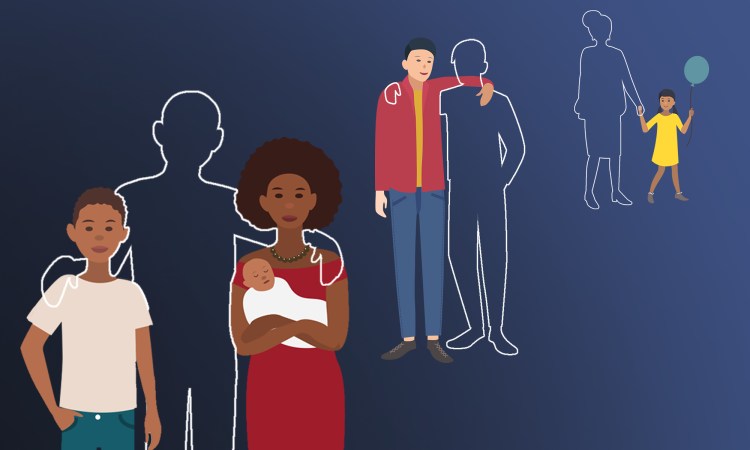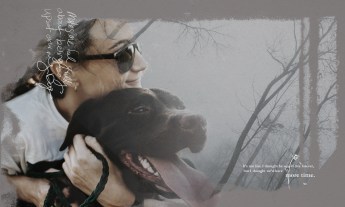
We can stay connected to them by creating our own special rituals, says psychologist and grief expert Kim Bateman.
In 1990, one of my younger brothers died in an avalanche while extreme skiing. He was only 21, and the horrific memory I have from that time is of his body lying at the bottom of a 750-foot cliff, all his bones broken. When he was little, he used to break his bones a lot because he was a risk taker, and the doctors always commented on how quickly he healed. But this time I knew there would be no healing, for him or for our family. It seemed like our identities shattered alongside his body on the rocks.
My son, who was four, asked me, “What happens when you die? Where did Chad go?” Being an academic, I said, “Well, Christians believe he’s in heaven with God, and Buddhists believe he’s going to come back as something or someone else. And there are scientists who believe we’re all made of energy and we just rejoin the natural cycle when we die.” And my son looked at me with wide eyes and said, “Yes, Mommy, but what do we believe?”
When we’re forced to say goodbye to someone in the physical form, we’re also being offered an opportunity to say hello to them in our imaginations.
It was a good question and I started looking to my own discipline, psychology, for answers. Some grief theorists say we humans invest our love or energy in a person and when she or he dies, we withdraw that energy and reinvest it in other people or projects. While that perspective may help some, it missed the mark for me. Because when we lose a loved one, we still love them. And I wasn’t ready to stop loving.
Then I came across this Japanese proverb, which said, “My barn having burned to the ground, I can now see the moon.” I loved this quote, because it introduced me to the idea that when we’re forced to say goodbye to someone in the physical form, we’re also being offered an opportunity to say hello to them in our imaginations. Although gone in the material world, our loved ones can become more psychologically present to us.
And we can use this presence to create rituals that will bring them back and provide us with a means through which we can still love them. One example comes from a folktale I’ve heard about a woman named Nyctea, which means “of the night” and evokes the spirit of the owl. Nyctea’s job is to protect that which is in danger of being lost in this world, so her cave is filled with bones. She has mouse bones and rattlesnake bones and hawk bones and coyote bones, but the most precious bones are those of her namesake, the owl. She combs the mountains and riverbeds and gathers them one by one, bringing them back to her cave. There, she patiently reconstructs the owl’s skeleton. When the skeleton is complete, she sits by her fire and thinks of what song she will sing. In this quiet moment of love, the great drum of her heart becomes audible. The rhythm gives rise to a song and she sings into being the owl’s smooth feathers, its broad wings and its round eyes. On her last note, she breathes life into the owl, and when it feels that life in its lungs, its yellow-green eyes open wide and it flies up out of the cave and into the world.
We must gather our loved ones’ bones and piece them together — they will be the lifeline that carries us through our grief.
When we grieve, aren’t we all a little like Nyctea? Aren’t we collecting bones and protecting that which is in danger of being lost? When my brother died, I remember that every word he had written suddenly seemed important. We wanted to dance to his music and to smell his clothes. The small pin he owned that said “Just visiting this planet” seemed like a premonition. We must gather our loved ones’ bones and piece them together — they will be the lifeline that carries us through our grief.
As a clinical psychologist, I’ve taught about death and dying and facilitated grief workshops for more than 20 years. I’ve seen many people sing over bones, each in their own way. One woman in my town lost her 18-month-old son in a horrific car accident. Two months after it occurred, when she was living in the most jagged places of mourning, she re-read the sheriff’s report. It said an unsecured car seat may have contributed to the fatality. So she set up car seat checkpoints and people lined up for blocks. She was a tiny person, and she’d get into each car, put her knee in there, and pry and pull and tug until the seat was secure. She said every time she pulled on a seat belt, she felt like she was loving her son.
I worked with a six-year-old girl whose mother died of breast cancer. She also felt responsible for her little brother who was only four, and her father was beside himself with grief. I said, “Tell me about your mother,” and she told me, “Mama loved tea.” She came up with the idea of holding a tea party for her. On Sundays, she’d set places for her brother, herself and her mother, and she and her brother would tell their mother about what happened to them that week. After a couple of months, even their father joined in. That girl is now in college, and she says it’s still a meaningful ritual. Whenever she wants to talk to her mother, she just puts an empty teacup across the table from herself.
Another woman lost her husband after 45 years of marriage. Since he was the one who drove, she decided she’d walk or take the bus instead. Through an interminable, gray, windy winter, she kept noticing one thing. It seemed like everywhere she went, there were single gloves laying on the ground. Something about these gloves spoke to her because they were useless without their mate, so she bent down and picked them up. She started bringing them home and put them in a dresser drawer until it overflowed. Then, she took out her husband’s ladder and carried it to the tree in the backyard that they’d planted together on their wedding day. She climbed the ladder and hung all the gloves — fastened to fishing lines — on the tree’s bare branches. She said when the wind blows, it’s like they are waving goodbye and waving hello.
When my children were little, on the anniversary of my brother’s death I used to take them to the river with a purple rose (my brother loved the Grateful Dead). The children took turns pulling off its petals. With every petal they removed, I’d tell them something about their uncle and then they’d throw it in the water. Together, we would watch those memories and stories float away.
To create your own ritual, ask yourself what brought joy to your loved one. The more specific you can be with your answers, the better.
How can you do this in your own life? As the story of Nyctea suggests, start by listening to the great drum of your heart. Let it be your guide. Then, there are a number of questions that can direct you in creating a ritual. Ask yourself what brought joy to your loved one; the more specific you can be with your answers, the better. Maybe Nana loved putting up ham pies for Easter, your uncle sang Frank Sinatra in his underwear on the balcony, your cousin wore a shirt under his graduation gown that said “My parents just think I went to college,” or your sister loved the tingly feeling of catching snowflakes on her tongue. Think about your loved one and what they enjoyed.
Also, think about the physicality of the person you lost. Were they small like a bird, tall like a giraffe, or substantial like an ox? What did it feel like to hug them, and who was the first to let go? What smell do you associate with them? Maybe it’s fresh-cut grass, Trident gum, sesame oil, lilac, peaches or clove cigarettes. When you were with your loved one, how did they make you feel? Was it like climbing into a comfortable easy chair and you always felt better about yourself? Or was it more like a rollercoaster ride and they tested you? What values did she or he feel strongly about? Maybe it was a good work ethic, social justice, freedom or fairness — you can try to incorporate that ideal into your own ritual.
When we sing over the bones of the people we care for, we are sitting in the place of the greatest love imaginable. And we’re not only singing up new life for our loved one, but we’re also singing up new life for ourselves. Poet W.S. Merwin wrote, “Your absence has gone through me/Like thread through a needle./Everything I do is stitched with its color.” May your song be colorful, and may you keep loving.
This piece was adapted from Dr. Bateman’s TEDxYouth@GrassValley Talk. Watch it now:











